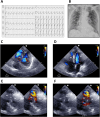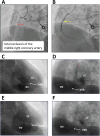Case Report: Two-patch technique with BioGlue salvages a patient with acute inferior wall myocardial infarction complicated by ventricular septal rupture and cardiogenic shock
- PMID: 41126913
- PMCID: PMC12537764
- DOI: 10.3389/fcvm.2025.1666868
Case Report: Two-patch technique with BioGlue salvages a patient with acute inferior wall myocardial infarction complicated by ventricular septal rupture and cardiogenic shock
Abstract
Post-myocardial infarction ventricular septal rupture (VSR) is a rare but often fatal complication of acute myocardial infarction (AMI). Without surgical or percutaneous intervention, mortality is exceedingly high. Even with corrective procedures such as surgical repair or transcatheter septal closure, in-hospital mortality remains substantial, particularly in hemodynamically unstable patients. We report a case of acute inferior-posterior wall ST-segment elevation myocardial infarction complicated by a large VSR and cardiogenic shock. Immediate venoarterial extracorporeal membrane oxygenation support was initiated. The patient subsequently underwent surgical repair using a modified infarct exclusion technique, in which BioGlue was applied between two patches to reinforce closure, and the second patch was extended into the ventriculotomy to simplify the procedure. The patient survived and remained free of recurrent VSR at the 5-month follow-up. This modified approach offers a feasible and effective strategy for managing acute inferior-posterior VSR following AMI, particularly in critically ill patients.
Keywords: acute myocardial infarction; cardiac surgery; cardiogenic shock; post-infarction ventricular septal rupture; ventricular septal rupture.
© 2025 Chang, Chen, Tsai and Chen.
Conflict of interest statement
The authors declare that the research was conducted in the absence of any commercial or financial relationships that could be construed as a potential conflict of interest.
Figures



References
-
- Crenshaw BS, Granger CB, Birnbaum Y, Pieper KS, Morris DC, Kleiman NS, et al. Risk factors, angiographic patterns, and outcomes in patients with ventricular septal defect complicating acute myocardial infarction. GUSTO-I (Global Utilization of Streptokinase and TPA for Occluded Coronary Arteries) trial investigators. Circulation. (2000) 101(1):27–32. 10.1161/01.cir.101.1.27 - DOI - PubMed
-
- Arnaoutakis GJ, Zhao Y, George TJ, Sciortino CM, McCarthy PM, Conte JV. Surgical repair of ventricular septal defect after myocardial infarction: outcomes from the Society of Thoracic Surgeons national database. Ann Thorac Surg. (2012) 94(2):436–43. 10.1016/j.athoracsur.2012.04.020 - DOI - PMC - PubMed
Publication types
LinkOut - more resources
Full Text Sources

